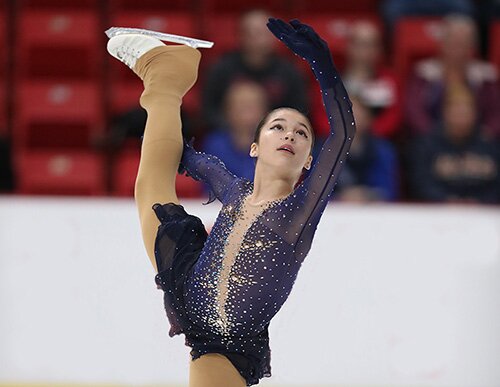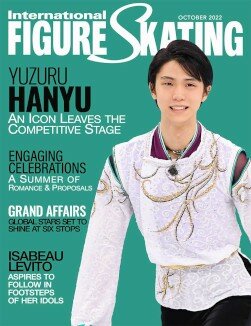

There was a time when junior skaters were, well, junior skaters. In a bygone era, those at that level were considered up- and-coming talents that executed double jumps, throws and twists — and fell a lot.
But those days are long gone. While the level of skating in the junior ranks has been rising every season, those at the top took it to an entirely new level this year. The current crop of future champions turned up with multiple quads, triple Axels and difficult triple-triple combinations in their arsenals.
Though some decry the stress these jumps are causing their growing bodies, it is the nature of elite athletes in all sports to push the boundaries — to go higher, faster and do things that have never been done before. With skaters now being taught solid technique, they learn difficult jumps at an early age and grow into themselves in a way that the generations before them did not.
On more than a few occasions during the seven-event Junior Grand Prix Series, the ladies and men earned scores that would have placed them in the top five at any given senior competition.
At the Junior Grand Prix in Poland, Russia’s Daniil Samsonov and Yuma Kagiyama of Japan earned scores that would have placed them first and third at the senior Challenger event, U.S. International Classic, and first and second at Nebelhorn Trophy by a runaway margin of 30 and 25 points, respectively.
Likewise, three of the top four ladies that qualified for the Junior Final — Kamila Valieva, 13; Alysa Liu, 14; and Ksenia Sinitsyna, 15 — earned scores throughout the junior Series that would have seen them claim all three steps of the ladies podiums at the same competitions.
Given that juniors are not permitted to include quad jumps in their short programs and ladies are not permitted to execute triple Axels, their scores are even more impressive.
Russia earned the most places on the Grand Prix circuit due to the success of its skaters at the 2019 World Junior Championships, which determines the allotments for the following season. Though that nation once again topped the overall standings of the Junior Grand Prix Series, capturing 44 of the 75 medals awarded, the tide is slowly changing with skaters from other nations stepping out of the shadows and onto the podiums.
The trio of Russian ladies that dominated the junior circuit the last two seasons have all moved into the senior ranks. To date, the generation that has come up behind them has not enjoyed the same success as their predecessors. But given their past history, many expected — before the season began — that the Russian ladies would dominate the Series.
Though they claimed 10 titles in total this year, they came up against two very strong competitors in the form of Alysa Liu of the U.S. and South Korea’s Haein Lee, who captured the top steps of four podiums, each time defeating at least one Russian lady.
For the second consecutive season, no Japanese ladies qualified for the Final, and only one — Rino Matsuike — claimed a medal (bronze) at the stop in Latvia.
The 2019 Junior Grand Prix Final takes place in Torino, Italy, in December and there is no doubt it will be one of the most hotly-contested events we have yet seen from those in the junior ranks. By the time the 2021-2022 season rolls around — just 26 months from now — many of the top juniors from this season and the next will be age-eligible to challenge for berths at the 2022 Olympic Winter Games in Beijing.
The 2021 senior competitive season will be intense, with the veterans battling it out with a younger generation for a place on their respective national teams.
GIRL POWER
The 2019 Junior Grand Prix Series opened in Courchevel, France, in late August and concluded in Egna-Neumarkt, Italy, in early October.
Three disciplines — men’s, ladies and ice dance — were contested at the first stop in Courchevel, and for all three winners it was the first Junior Grand Prix victory of their young careers.
In her debut on the international circuit, Russia’s Kamila Valieva, 13, captured the ladies crown — and the first medal of the Series — with more than nine points to spare. Coached by Eteri Tutberidze, Valieva has a natural artistic flair and her short program — inspired by the Pablo Picasso painting “Girl on the Ball” — is a work of art.The teenager had been landing quad toes in practice and cleanly executed one in her long program in Courchevel.
However, that was not what solidified her victory, as the base value for a quad toe is less than that of a triple Lutz-triple toe combination. It was her program component scores (PCS), which ranged from 7.25 to 8.50 (a reflection of her skating skills, performance and interpretation) — that made the difference.
Three weeks later, after many entry changes in the ladies lineup for the stop in Chelyabinsk, Russia, it was Valieva who was eventually named the lucky winner of the lottery to compete at the Grand Prix on home soil. Situated in west-central Russia, Chelyabinsk became known to the world after a meteor exploded over it in 2013.
Once again, Valieva was the star of the show.This time she attempted two quads in her free skate, the first in combination with a double toe, but was unable to hold on to the landing of the second one. Despite the fall, Valieva captured the title in a runaway victory, leading a Russian sweep of the podium and punching her ticket to the Junior Grand Prix Final.
The much-awaited Series debut of Alysa Liu of the U.S. took place at the second stop in Lake Placid, New York. The 14-year- old made history at her first international competition when she became the first lady — junior or senior — to land a triple Axel and a quad jump (Lutz) in the same program, and the first American lady to ever land a quad jump in competition.
Liu had planned two triple Axels in her free skate, but a hesitation heading into the second attempt led to a fall. Nonetheless, Liu — the first non-Russian to claim a Junior Grand Prix ladies title since 2016 — scored a runaway victory, winning the competition by a 21.42-point margin over the second-place finisher.
Proving that her victory in Lake Placid was not a fluke, three weeks later Liu captured her second Junior Grand Prix title in Poland. Fourth after the short, she landed both triple Axels (the first in combination) along with the quad Lutz and six other clean triple jumps in her long program. With two victories under her belt, Liu collected 30 points and ranked second in the overall standings for the Junior Grand Prix Final. Though she has strong technical skills, her PCS do not match those of Valieva, and that could make all the difference in Torino this December.
The other spoiler on the circuit this season was Haein Lee of South Korea. The 14-year-old has neither a quad nor a triple Axel in her repertoire but with strong skating skills, solid technique and a sense of musicality, she proved she is a contender. At her first assignment in Latvia, Lee ended a seven-year gold medal drought for South Korean ladies when she claimed the top step of the podium, defeating Russia’s Daria Usacheva by 3.23 points.
The last lady from Korea to win a Junior Grand Prix crown was Hae-Jin Kim in 2012. Lee was four months old when Yuna Kim won her nation’s first junior title in 2005.
Three weeks later, Lee repeated her golden feat in Croatia, again defeating Usacheva, this time by a margin of 6.21. With 30 points for her two victories, she heads into the Junior Final ranked third.
Russia’s Ksenia Sinitsyna, who finished third at her sole Junior Grand Prix event in 2018, was originally scheduled to open her season in Lake Placid. However, she was forced to miss the competition when passport control officials at Moscow airport advised her that she did not have a valid visa to enter the U.S. and she was not permitted to board her flight. Sinitsyna was subsequently assigned to the event in her Russian homeland. The 15-year-old from Tver, who is coached by Svetlana Panova and Tatiana Moiseeva in Moscow, finished second behind Valieva.
However, Sinitsyna stepped it up at her second assignment in Italy, winning the competition with a much-improved score and capturing the title by a whopping 39.37-point margin over her teammate Anna Frolova. With 28 points, Sinitsyna captured the fourth berth at the Final.
Usacheva landed in fifth place overall in the ladies standings with two silver medals to her credit and is also headed to the Final. Likewise, her teammate Viktoria Vasilieva, third in Russia and second in Poland, earned a ticket to Torino. Frolova is the first alternate.
THE MEN’S BATTLE
The Russian men were impressive on the circuit this season, ultimately capturing three of the six berths at the Final. A pair of talented Japanese men claimed two, with the last one going to Italy. Only one man who qualified for the 2018 Grand Prix Final, Russia’s Petr Gumennik, is back on the Final roster. Two other men who returned to the circuit this season — Canada’s Stephen Gogolev and Adam Siao Him Fa of France — did not make the cut.
Russia’s Andrei Mozalev, 16, claimed top spot on the leaderboard at the end of the Series. The St. Petersburg native captured the first men’s title of the season for his nation in Latvia — and just the second of his young career. Though his short program was clean, Mozalev left a lot of points on the table with minus grades of execution (GOEs) on five elements in the free. Nonetheless, he claimed the title by a comfortable margin.
He was determined not to repeat the result of last season, when he won his first event but crashed to sixth at his second. Three weeks after his victory in Latvia, Mozalev mined a second gold in Croatia, winning the competition by a 12.62-point margin. He ranks first on the leaderboard heading into the Final.
In his second season on the circuit, Japan’s Yuma Kagiyama returned with a much improved skill-set, artistry and polish than he had displayed in 2018. Last season, he finished ninth in the overall standings and this year he ranks second. In order to fulfill his pre-season goals of earning a place at the 2020 Youth Olympic Games and World Junior Championships, he knew he would need to post solid results at his two assignments.
At his first event in Courchevel, Kagiyama scored a dominant victory, winning the competition by a 34.16-point margin. With two quad toes in his repertoire, he was the class of the field in France. Things did not go quite as well at his second event. Despite skating well and receiving just one under- rotation call on a triple Axel, he had to settle for second place.
Kagiyama, 16, is coached by his father Masakazu Kagiyama, the 1989 World Junior bronze medalist and a two-time Olympian (1992 and 1994).
In the seven months since the skating world last saw Gumennik — the 2018 Junior Grand Prix Final silver medalist — a lot has changed. Not only has he grown height-wise, he has taken his standard of skating to a much higher level. In Chelyabinsk, he led a Russian sweep of the podium — the only one in the men’s discipline this season — and narrowly claimed his third Junior Grand Prix title by a margin of 0.21 of a point over his teammate Artur Danielian.
At his second event in Italy — the final stop of the Series — Gumennik found himself in second place in both the short and long programs. Most of his problems stemmed from deductions for under-rotated jumps and a fall on a quad. Gumennik, 17, has not quite mastered either of the two quads in his long program — Lutz and Salchow — but expect him to bring improved versions to Torino. The St. Petersburg native said his free skate is very difficult with many new elements. He initially considered not including a quad “because at past events you could easily win without a quad,” but realized that is no longer the case.
Italy’s Daniel Grassl was looking for redemption after a not so successful Junior Grand Prix debut last season. In Gdańsk, the 17-year-old from Merano was hit with a deduction on the quad Lutz and under- rotation calls on a quad loop and a triple Axel. Those errors combined with relatively low PCS left him in a distant third, 21.87 points out of first place.Things did not look promising for him to achieve his goal of making it to his first Final.
However, at his second assignment on home soil in Italy, Grassl stepped it up, capturing the short by a narrow margin over Gumennik. He carried that momentum into the free, and although there were no under-rotation calls, he received minus GOEs for insecure landings on the quad loop and the triple Axel. But with six of seven triples deemed clean, Grassl captured the title and wrote his own piece of history as the first Italian man to ever claim a place at a Junior Final. He sits fourth in the overall standings.
Russia’s Daniil Samsonov, 14, was obviously nervous as he took to the ice for the free skate at his debut event in Latvia. It showed when the Moscow native took a tumble on the quad Lutz and triple Lutz, both of which were downgraded. But, sitting in the kiss and cry, the look of disappointment with his performance was shaded with one of silent determination to do better next time. Though he finished third overall in his debut, he ranked first in the charm department, capturing the hearts of fans around the world with his gentle demeanor.
At his second event in Poland, Samsonov was clearly out for redemption, and came out firing in both programs. First in the short, he carried that momentum into the free where, despite taking another tumble on a quad Lutz, he went on to execute eight high-quality triple jumps. He claimed the title with a score of 250.51 – the highest earned by any man throughout the Series. Both his technical score and PCS were much improved from his first outing. Samsonov finished fifth in the standings and is headed to Torino for the Final.
Japan’s Shun Sato, 15, mined gold in his Junior Grand Prix debut in the U.S., outskating the favored Gogolev to take the title. It was a decisive victory for Sato who put 13.42 points between himself and the Canadian — despite earning minus GOEs for four jumping passes — and made it two victories in a row for the Japanese men. However, his second event in Zagreb, Croatia, did not go as well. Fourth in both the short and long programs, Sato was again hit with minus GOEs for both quad toes — a repeat of Lake Placid — and received an edge call on a triple flip. He finished third overall behind two Russian men, but with 26 points he claimed the sixth and last berth at the Junior Final. Artur Danielian of Russia is the first alternate.
HIGH FLYERS
The pairs discipline was contested at only four of the seven events this year. As expected, the Russian teams were dominant, sweeping two podiums, with five teams qualifying for the Junior Grand Prix Final. A young German duo that had only been together six months when they competed at their first Junior Grand Prix event, captured the sixth spot.
Two of the Russian teams that made the cut in 2018 qualified again this season: Apollinaria Panfilova and Dmitry Rylov and with Ksenia Akhanteva and Valerii Kolesov.
In their third season on the junior circuit, Panfilova, 16, and Rylov, 18, were in a league of their own, leading a sweep of the podium at their first event in Lake Placid. That competition was no contest — the duo outdistanced the second-placed team by 15.73 points, and the third-place finishers by 27.63. Panfilova and Rylov claimed a second victory in Poland, but this time there would be no Russian sweep. Kate Finster and Balazs Nagy of the U.S. captured the silver ahead of Germany’s bronze medalists, Annika Hocke and Robert Kunkel. Two other Russian teams finished fourth and fifth, respectively.
At the end of the Series, Panfilova and Rylov topped the leaderboard and with the highest combined scores are ranked first heading into Torino.
In their debut on the junior circuit, Iuliia Artemeva, 14, and Mikhail Nazarychev, 18, captured silver in Chelyabinsk and upgraded that result to gold in Croatia, earning 28 points in total.They rank second in the overall standings. Akhanteva, 17, and Kolesov, 19, finished second in Lake Placid.They won their next event in Chelyabinsk, leading the second Russian sweep of the Series in the pairs discipline with a score that was almost 14 points higher than the total they achieved in the U.S. Despite qualifying for the 2018 Junior Final, where they finished fourth, this was just the second victory in two seasons for the St. Petersburg-based team. They were the first skaters to qualify for the 2019 Junior Grand Prix Final.
Diana Mukhametzianova, 16, and Ilya Mironov, 18, of Russia also impressed in their debut performances on the circuit, capturing bronze on home soil in Chelyabinsk and finishing second in Croatia. They rank fourth heading into the Final.
The German team of Hocke, 19, and Kunkel, 20, were the surprise of the season. Both had competed with other partners in the past and only teamed up in the spring of 2019. They made history at their first event in Poland when they claimed the bronze medal, the first ever for a German pairs team at a Junior Grand Prix event. Their third-place finish denied the Russians a third podium sweep. Hocke and Kunkel finished third a week later in Croatia and wrote their second historical note as the first German pairs team to ever qualify for a Junior Final. With 22 points to their credit they rank fifth on the leaderboard.
Rounding out the top six teams that qualified for the Final are Russia’s Alina Pepeleva and Roman Pleshkov. The duo competed at just one junior event last year, so this was their first full season on the circuit. Pepeleva and Pleshkov finished third in the U.S. and fourth in Poland, earning 20 points in total. The American team of Finster and Nagy are the first alternates.
DANCING DUOS
Avonley Nguyen and Vadym Kolesnik claimed their first ice dance title of the season on home soil in the U.S. The duo was the class of the field, winning the event by 10.63 points over Russia’s Diana Davis and Gleb Smolkin. It was a great start to the season after a disappointing fifth-place finish at the 2018 Junior Grand Prix Final. Nguyen, 16, and Kolesnik, 17, needed a top-two finish at their second event in Poland to qualify for the Final. In the end, it proved to be no contest with the American team running away with the victory by almost 12 points. Last season, they headed into the Junior Final ranked third but this year they sit at the top of the standings with 30 points and the highest combined scores.
Russia’s Elizaveta Shanaeva and Devid Naryzhnyy narrowly claimed the title at their first event in France, winning by a slim margin of 2.89 points. Motivated by their victory, the Moscow-based team worked on their musicality and technique in the weeks prior to their second competition.That work paid off for Shanaeva and Naryzhnyy who captured a second gold medal in Russia with a much-improved score. The team ranks second in the standings with 30 points, but their combined score from the two events is more than 10 points below that of the American duo.
Elizaveta Khudaiberdieva of Russia had a distinct advantage over most of the ice dancers on the circuit this season. Having competed on the junior circuit the previous two years with former partner Nikita Nazarov, with whom she finished second at the 2019 World Junior Championships, she had a wealth of experience to draw on. Khudaiberdieva, 17, and her new partner, Andrey Filatov, 18, who teamed up in the spring of 2019, proved to be a winning match. In their first competitive outing, they danced to the top of the podium in Latvia. Proving their triumphant debut was not a fluke, they won their second event in Italy and qualified third for the Final.
In 2018, Maria Kazakova, 18, and Georgy Reviya, 20, became the first skaters from Georgia to earn a place at a Junior Grand Prix Final, where they finished sixth. This year they came out blazing, having made a quantum leap in their basic skating skills and interpretation of their programs. However, their first competition of the current season in Latvia did not end as they had hoped. Second after the rhythm dance, the duo won the free dance but missed the top step of the podium by just 0.33 of a point.
Kazakova and Reviya did not let victory slip through their fingers at their second event in Croatia, where they won the competition with almost 15 points to spare. It was especially sweet, given that it was the first victory of their career on the junior circuit. The first Georgians (in any discipline) to ever win a Junior Grand Prix title, the duo headed into Torino ranked fourth.
Loïcia Demougeot, 17, and Théo Le Mercier, 20, of France, round out the top three non-Russian teams headed to the Final. The duo captured the silver medal in Courchevel — their first on the junior circuit — and repeated that success in Poland. They rank fifth with 26 points. Davis, 16, and Smolkin, 20, who train with Igor Shpilband in Novi, Michigan, mined silver at both their events this season. With 26 points, they captured the sixth berth at the Final. Davis is the daughter of Russian coach Eteri Tutberidze. Their teammates, Sofya Tyutyunina and Alexander Shustitskiy, are the first alternates.
RELATED CONTENT:
2020 WORLD JUNIOR CHAMPIONSHIPS




